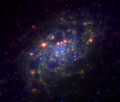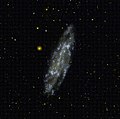| M81 Group | |
|---|---|
 | |
| Observation data (Epoch J2000) | |
| Constellation(s) | Ursa Major/Camelopardalis |
| Brightest member | M81 (pictured) |
| Number of galaxies | 34 |
| Other designations | |
| NGC 3031 Group | |
The M81 Group is a galaxy group in the constellations Ursa Major and Camelopardalis that includes the galaxies Messier 81 and Messier 82, as well as several other galaxies with high apparent brightnesses. The approximate center of the group is located at a distance of 3.6 Mpc, making it one of the nearest groups to the Local Group. The group is estimated to have a total mass of (1.03 ± 0.17)×10M☉. The M81 Group, the Local Group, and other nearby groups all lie within the Virgo Supercluster (i.e. the Local Supercluster).
Members
| This section needs additional citations for verification. Please help improve this article by adding citations to reliable sources in this section. Unsourced material may be challenged and removed. Find sources: "M81 Group" – news · newspapers · books · scholar · JSTOR (December 2024) (Learn how and when to remove this message) |
The table below lists galaxies that have been identified as associated with the M81 Group by I. D. Karachentsev.
| Name | Type | R.A. (J2000) | Dec. (J2000) | Redshift (km/s) | Apparent Magnitude |
|---|---|---|---|---|---|
| Arp's Loop | 09 57 32.6 | +69° 17′ 00″ | 99 | 16.1 | |
| DDO 78 | Im | 10 26 27.4 | +67° 39′ 16″ | 55 ± 10 | 15.8 |
| F8D1 | dE | 09 44 47.1 | +67° 26′ 19″ | 13.9 | |
| FM1 | dSph | 09 45 10.0 | +68° 45′ 54″ | 17.5 | |
| HIJASS J1021+6842 | 10 21 00.0 | +68° 42′ 00″ | 46 | 20 | |
| HS 117 | I | 10 21 25.2 | +71° 06′ 51″ | -37 | 16.5 |
| Holmberg I | IAB(s)m | 09 40 32.3 | +71° 10′ 56″ | 139 ± 0 | 13.0 |
| Holmberg II | Im | 08 19 05.0 | +70° 43′ 12″ | 142 ± 1 | 11.1 |
| Holmberg IX | Im | 09 57 32.0 | +69° 02′ 45″ | 46 ± 6 | 14.3 |
| IC 2574 | SAB(s)m | 10 28 23.5 | +68° 24′ 44″ | 57 ± 2 | 13.2 |
| IKN | 10 08 05.9 | +68° 23′ 57″ | 17.0 | ||
| KKH 57 | dSph | 10 00 16.0 | +63° 11′ 06″ | 18.5 | |
| Messier 81 | SA(s)ab | 09 55 33.2 | +69° 03′ 55″ | -34 ± 4 | 6.9 |
| Messier 81 Dwarf A | I | 08 23 56.0 | +71° 01′ 45″ | 113 ± 0 | 16.5 |
| Messier 82 | I0 | 09 55 52 | +69° 40′ 47″ | 203 ± 4 | 9.3 |
| NGC 2366 | IB(s)m | 07 28 54.7 | +69° 12′ 57″ | 80 ± 1 | 11.4 |
| NGC 2403 | SAB(s)cd | 07 36 51.4 | +65° 36′ 09″ | 131 ± 3 | 8.9 |
| NGC 2976 | SAc pec | 09 47 15.5 | +67° 54′ 59″ | 3 ± 5 | 10.8 |
| NGC 3077 | I0 pec | 10 03 19.1 | +68° 44′ 02″ | 14 ± 4 | 10.6 |
| NGC 4236 | SB(s)dm | 12 16 42 | +69° 27′ 45″ | 0 ± 4 | 10.1 |
| PGC 28529 | Im | 09 53 48.5 | +68° 58′ 08″ | -40 | 17.1 |
| PGC 28731 | dE | 09 57 03.1 | +68° 35′ 31″ | -135 ± 30 | 15.6 |
| PGC 29231 | dE | 10 04 41.1 | +68° 15′ 22″ | 16.7 | |
| PGC 31286 | dSph | 10 34 29.8 | +66° 00′ 30″ | 16.7 | |
| PGC 32667 | Im | 10 52 57.1 | +69° 32′ 58″ | 116 ± 1 | 14.9 |
| UGC 4459 | Im | 08 34 07.2 | +66° 10′ 54″ | 20 ± 0 | 14.5 |
| UGC 4483 | 08 37 03.0 | +69° 46′ 31″ | 156 ± 0 | 15.1 | |
| UGC 5428 | Im | 10 05 06.4 | +66° 33′ 32″ | -129 ± 0 | 18 |
| UGC 5442 | Im | 10 07 01.9 | +67° 49′ 39″ | -18 ± 14 | 18 |
| UGC 5692 | Sm | 10 30 35.0 | +70° 37′ 07.2″ | 56 ± 3 | 13.5 |
| UGC 6456 | Pec | 11 27 59.9 | +78° 59′ 39″ | -103 ± 0 | 14.5 |
| UGC 7242 | Scd | 12 14 08.4 | +66° 05′ 41″ | 68 ± 2 | 14.6 |
| UGC 8201 | Im | 13 06 24.9 | +67° 42′ 25″ | 31 ± 0 | 12.8 |
| UGCA 133 | dSph | 07 34 11.4 | +66° 53′ 10″ | 15.6 |
Note that the object names used in the above table differ from the names used by Karachentsev. NGC, IC, UGC, and PGC numbers have been used in many cases to allow for easier referencing.
Interactions within the group
Messier 81, Messier 82, and NGC 3077 are all strongly interacting with each other. Observations of the 21-centimeter hydrogen line indicate how the galaxies are connected. The gravitational interactions have stripped some hydrogen gas away from all three galaxies, leading to the formation of filamentary gas structures within the group. Bridges of neutral hydrogen have been shown to connect M81 with M82 and NGC 3077. Moreover, the interactions have also caused some interstellar gas to fall into the centers of Messier 82 and NGC 3077, which has led to strong starburst activity (or the formation of many stars) within the centers of these two galaxies. Computer simulations of tidal interactions have been used to show how the current structure of the group could have been created.
Gallery
-
 Galaxy UGC 8201 is a dwarf irregular galaxy member of the M81 galaxy group.
Galaxy UGC 8201 is a dwarf irregular galaxy member of the M81 galaxy group.
-
 Amateur picture Messier 81 + 82 and NGC 3077 all of the M81 group, 33 frames stacked of 1 minute each.
Amateur picture Messier 81 + 82 and NGC 3077 all of the M81 group, 33 frames stacked of 1 minute each.
-
 The spiral galaxies Messier 81 and 82 and the dwarf galaxy Holmberg IX from GALEX
The spiral galaxies Messier 81 and 82 and the dwarf galaxy Holmberg IX from GALEX
-
 Close up view of Messier 81 from GALEX
Close up view of Messier 81 from GALEX
-
 The spiral galaxy Messier 81 from Spitzer Space Telescope
The spiral galaxy Messier 81 from Spitzer Space Telescope
-
 The spiral galaxy Messier 81 from Spitzer Space Telescope
The spiral galaxy Messier 81 from Spitzer Space Telescope
-
 Starburst galaxy Messier 82 from Hubble Space Telescope
Starburst galaxy Messier 82 from Hubble Space Telescope
-
 NGC 2403 in mid-infrared view, combining the 3.6, 5.8 and 8.0 μm bands of the Spitzer Space Telescope
NGC 2403 in mid-infrared view, combining the 3.6, 5.8 and 8.0 μm bands of the Spitzer Space Telescope
-
 NGC 2403 in Mid-infrared view, combining the 3.6, 8.0 and 24 μm bands of the Spitzer Space Telescope
NGC 2403 in Mid-infrared view, combining the 3.6, 8.0 and 24 μm bands of the Spitzer Space Telescope
-
 NGC 2403 from Hubble Space Telescope
NGC 2403 from Hubble Space Telescope
-
 NGC 2403 from Hubble Space Telescope illustrated
NGC 2403 from Hubble Space Telescope illustrated
-
 Supernova SN2004DJ in the spiral galaxy NGC 2403
Supernova SN2004DJ in the spiral galaxy NGC 2403
-
 Supernova 2004dj in NGC 2403
Supernova 2004dj in NGC 2403
-
 NGC 4236 from GALEX
NGC 4236 from GALEX
-
 NGC 2366 from Hubble Space Telescope
NGC 2366 from Hubble Space Telescope
-
 Galaxy NGC 2976 from Spitzer Space Telescope in infrared
Galaxy NGC 2976 from Spitzer Space Telescope in infrared
-
 Galaxy NGC 2976 from an amateur Astronomer
Galaxy NGC 2976 from an amateur Astronomer
-
 Galaxy NGC 4605 from GALEX
Galaxy NGC 4605 from GALEX
-
 NGC 2363 from Hubble Space Telescope
NGC 2363 from Hubble Space Telescope
-
 NGC 2537 from GALEX
NGC 2537 from GALEX
-
 Holmberg II from Spitzer Space Telescope in infrared
Holmberg II from Spitzer Space Telescope in infrared
-
 UGC 5423 / M81 dwarf B from Spitzer Space Telescope in infrared
UGC 5423 / M81 dwarf B from Spitzer Space Telescope in infrared
-
 NGC 3077 from 2MASS
NGC 3077 from 2MASS
-
 IC 2574
IC 2574
See also
References
- ^ I. D. Karachentsev (2005). "The Local Group and Other Neighboring Galaxy Groups". Astronomical Journal. 129 (1): 178–188. arXiv:astro-ph/0410065. Bibcode:2005AJ....129..178K. doi:10.1086/426368. S2CID 119385141.
- Karachentsev, I. D.; Kashibadze, O. G. (2006). "Masses of the local group and of the M81 group estimated from distortions in the local velocity field". Astrophysics. 49 (1): 3–18. Bibcode:2006Ap.....49....3K. doi:10.1007/s10511-006-0002-6. S2CID 120973010.
- R. B. Tully (1982). "The Local Supercluster". Astrophysical Journal. 257: 389–422. Bibcode:1982ApJ...257..389T. doi:10.1086/159999.
- ^ "NASA/IPAC Extragalactic Database". Results for various galaxies. Retrieved 2007-02-09.
- ^ M. S. Yun; P. T. P. Ho; K. Y. Lo (1994). "A high-resolution image of atomic hydrogen in the M81 group of galaxies". Nature. 372 (6506): 530–532. Bibcode:1994Natur.372..530Y. doi:10.1038/372530a0. PMID 7990925. S2CID 4369085.
- ^ Chynoweth, Katie M.; et al. (2008). "Neutral Hydrogen Clouds in the M81/M82 Group". The Astronomical Journal. 135 (2008 June): 1983–1992. arXiv:0803.3631. Bibcode:2008AJ....135.1983C. doi:10.1088/0004-6256/135/6/1983. S2CID 4490764.
- Hulst, J. M. van der (1978). "The Structure and Kinematics of the Neutral Hydrogen Bridge Between M 81 and NGC 3077". Astronomy and Astrophysics. 75 (1–2): 97–111.
- Yun, M. S. (1999). "Tidal Interactions in M81 Group". Galaxy Interactions at Low and High Redshift, Proceedings of IAU Symposium. 186: 81. Bibcode:1999IAUS..186...81Y. doi:10.1007/978-94-011-4665-4_18. ISBN 978-0-7923-5833-6.
- "The mysteries of UGC 8201". Retrieved 18 June 2015.